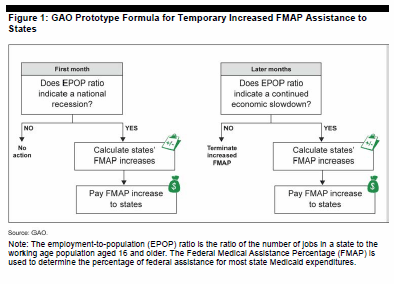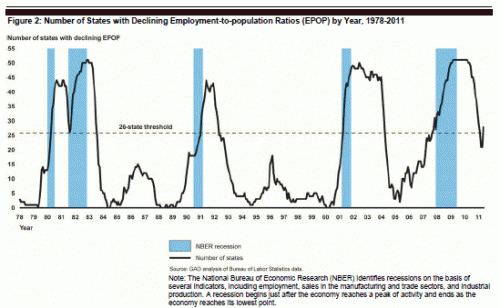The GAO has proposed a Medicaid matching formula that would better target federal resources to states during economic downturns when Medicaid enrollment typically increases. When the Employment to Working Age Population (EPOP) ratio dropped in 26 states, an increase in the federal cost share (Federal Medical Assistance Percentage, FMAP) of the Medicaid program would be triggered automatically, and would remain in place until the EPOP returned to pre-recession levels. The EPOP measure would not be influenced by persons “giving up” and leaving the labor force, so provides a more precise measure of economic hardship in a state that is likely to trigger Medicaid enrollment increases than would unemployment.
 If this policy had been in place during the recent recession, increases in federal aid for Medicaid to states would have begun in January, 2008 and ended in September, 2011 and would have increased federal costs by $36 Billion. Under the Recovery act, the dates of increase were October, 2008 to June, 2011, but GAO notes the amounts are not directly comparable because they were not only designed to respond to recession-driven cost increases.
If this policy had been in place during the recent recession, increases in federal aid for Medicaid to states would have begun in January, 2008 and ended in September, 2011 and would have increased federal costs by $36 Billion. Under the Recovery act, the dates of increase were October, 2008 to June, 2011, but GAO notes the amounts are not directly comparable because they were not only designed to respond to recession-driven cost increases.
GAO suggests that moving to this formula would provide a more predictable amount of federal support for Medicaid during economic downturns. HHS is generally positive about this change per comments it provided on the GAO report, but suggested that more work is needed to identify the appropriate number of states experiencing a downturn based on the EPOP measure that must be observed before increased FMAP share is granted (many options). However, GAO points out that the 26 state threshold is closely correlated historically with the official beginning of recessions, and is easily measured, allowing for an automatic and quick response.
Medicaid is a counter-cyclical program that means costs for states rise just as tax receipts generally fall. This proposal would shift more of this extra recession-driven burden to the federal government, which is better able to deficit finance during economic downturns than are states. The proposed policy makes sense so long as we are roughly maintaining Medicaid in its current safety net role. Moving toward block granting of Medicaid is really the polar opposite approach; fixing the per capita Medicaid costs of the federal government no matter what, with more of the burden being shifted to states.
Fairly stark policy options.


